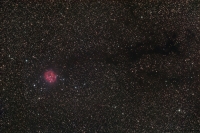Imaging conditions steadily improve as we proceed through August and once again reasonably dark skies can be had in the late evening – the only problem being if you have a day job to get up early for the next morning!! Day jobs notwithstanding August sees the real beginning of the new imaging season and as we’re still in summer it’s the summer constellations that we’ll still be interested in. Cygnus again (same as last month) but this time a beautiful nebula rather than the open cluster we saw last month – this time we’ll look in some detail at the Cocoon nebula [IC5146].
The Cocoon nebula itself is a beautiful little emission nebula some 10′ x 10′ in size at a distance of around 3,300 light years. But it is not just the nebula that is interesting – look at its surroundings!! This one lies in the rich Milky Way and there’s yet another bonus – look at those dark nebula streamers billowing out from behind the Cocoon – it looks like the Cocoon has blundered its way into this Milky Way region of stars from the right, pushing stars out of its way as it travelled through and finally came to rest. This amazing dark nebula is Barnard 168 [B168] and is one of the northern sky’s most visually stunning dark nebulae when viewed through a low-power instrument. It is also large! The accompanying image is a two-frame Hyperstar III mosaic measuring some 4 degrees across – and it still wasn’t a big enough FOV to capture the full extent of B168!
Now go back to the Cocoon nebula again – and look at that amazing stream of stars coming out the top of the nebula looking like some celestial whale head blowing sea water out of its blow-hole – incredible!
This region demands a LOT of exposure time AND a huge field of view as well. It is well worth the time and effort to put together a nice mosaic of this area to capture the full richness of the region. For my Hyperstar III/SXVF-M25C setup I recommend 5-minute subs to get some real depth to the Milky Way stars, and as per usual, at least 4-hours per frame, preferably 5-hours to give around 60 subs for a decent stacking and good signal to noise.
I will almost certainly go back to this one to get the third frame off to the right to get a little more of the amazing B168 into the final image.
Until September, when we WILL be getting those darker skies – clear skies and happy imaging!!


